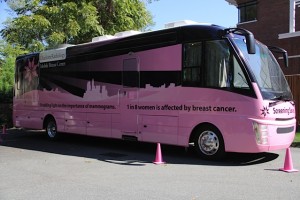By Dr. Debbie Agisim
Charlotte Radiology Breast Center
Breast Imaging Specialist
Smarty Moms, let’s get to the bottom of this mystery called mammography. I’m 35 and my doctor has recommended a baseline mammogram. What is a mammogram, after all? Why do I need one? I don’t have a family history. I just don’t have enough time to take care of me. I’m a busy mom too – so I definitely get it. I hope that the following information will prompt you to finally schedule that baseline mammogram that your doctor’s been badgering you about for a year now. Or remind you to finally schedule your annual mammogram exam that you’ve put off for months now.
So, what is a mammogram?
Screening mammography is used to detect breast cancer in women who have no breast complaints or symptoms. Screening mammography is intended to detect breast cancer in the earliest stage possible when it is most treatable. Diagnostic mammography is performed when a woman has a breast lump or other symptoms (such as a pain or nipple discharge). A diagnostic mammogram may also be performed if your screening mammogram demonstrates a possible abnormality. Do not be alarmed – this is very common, especially for women getting their first mammogram.
Why is FORTY the magic number?
The U.S. Department of Health and Human Services (HHS), the American Cancer Society (ACS), the American Medical Association (AMA) and the American College of Radiology (ACR) all recommend screening mammography every year for women, beginning at age 40. In addition, many women obtain a baseline mammogram at age 35. The baseline is intended to give radiologists a point of comparison for breast tissue changes through the years.
As we age, our risk of developing breast cancer increases. Statistics from the National Cancer Institute show that between the ages of 40-49, a woman with an average risk of breast cancer (i.e. – no family history) has a 1.46 % chance of developing breast cancer. This percentage represents a significant rise compared with women aged 30-39, who have a 0.44% chance of developing breast cancer. This jump in the incidence of cancer after age 40 is one main reason why annual screening mammography is recommended at this age. Additionally, a woman’s breast density typically decreases with age. This improves mammographic sensitivity and the detection of breast cancer with age. Regardless of age, women with a family history or experiencing a breast problem should contact their primary care physician for further evaluation.
I don’t have a family history.
MOST women who develop breast cancer have no family history. A woman’s chance of developing breast cancer increases if a first degree relative such as a mother, sister or daughter has been diagnosed with breast cancer. Women who are at higher than average risk of breast cancer should talk with their health care providers about whether to have mammograms before age 40 and if any additional measures need to be considered.
The bottom line is annual mammograms help detect breast cancer early and improve the chances that it can be treated successfully. A mammogram can show changes in the breast up to two years before a patient or physician can feel them.
Don’t skip!
It is important to get mammograms on an annual basis – your mammogram images are like pieces of a puzzle – the radiologist uses these images to look for subtle changes that could be indicators of early stage breast cancer. Having prior films for comparison also reduces the chance that you are called back in for a diagnostic evaluation.
American Cancer Society Guidelines for early detection of breast cancer:
Women age 40 and older should have a screening mammogram every year, and should continue to do so for as long as they are in good health.
Women in their 20s and 30s should have a clinical breast exam (CBE) as part of a regular health exam by a health professional, preferably every 3 years. After age 40, women should have a breast exam by a health professional every year.
Breast self-exam (BSE) is an option for women starting in their 20s. Women should be told about the benefits and limitations of BSE. Women should report any breast changes to their health professional right away.
As per American Cancer Society recommendations, women at high risk (20% or greater lifetime risk) should get an MRI and a mammogram every year beginning at age 30. Women at moderately increased risk (15% to 20% lifetime risk) should talk with their doctors about the benefits and limitations of adding MRI screening to their yearly mammogram.
Don’t wait! Visit beatcancerCR.com for more information.




1 comment
We are putting together our monthly newsletter calendar of events and programs for Charlotte community when it come to cancer. I want to know what events or location you would like to highlight for the November. We would love to share Smarty Pants on our newsletter to others and possible look into working together on a few events for 2013.
Please give me a call 704-352-9556 or email me dany@amped4acure.org
Get Amped!
Thanks again
Dany Eason